If a Falco Project
Could Only Talk
![]()
If a Falco Project
|
|
by David and Sian Thomas
|
This article appeared in the March 2004 Falco Builders Letter. |
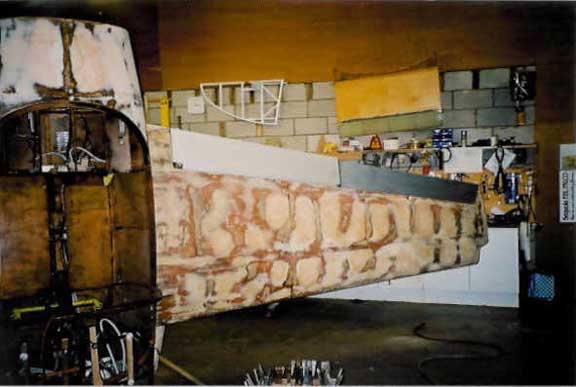
The wing filled with microballoons
This Falco project was started in 1982, with most of the basic airframe being completed and signed off by 1984, according to my records. The project passed on to Pat Millar and then Bob Sothcote. Bob was featured in Kitplanes magazine around 1990, with a photograph of the aeroplane as it was then. The aeroplane stood on its undercarriage with all the skins fitted apart from the top of wing skins. Around this time Bob bought the cowling, instrument panel and electrical kit from Sequoia. I believe the canopy and undercarriage components were also sourced at this time, possibly from Falco G-AVUJ which was destroyed in a hanger fire during the late 80’s.
I first saw the aircraft three years ago when Dave Almey bought the project from Bob, and asked me if I would help retrieve it over the Christmas break. Little did I know I would eventually own it! We traveled with two trucks and trailers and four men. My first sight of the plane was as the door of a ramshackle barn opened, showing the wings and cockpit lying diagonally across the barn, the port wingtip resting on the ground and the starboard tip up in the air on the diagonal side of the barn. It just fitted, with the tail section sitting half over the wing and supported on straw bails! Under all this lay the undercarriage on the bare earth. Oh, what a sorry sight. I wish I had taken photographs.
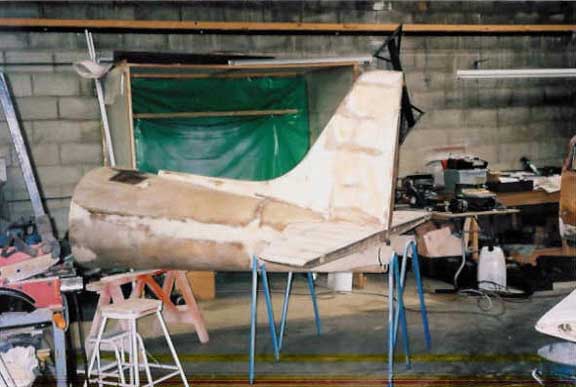
The tail section
How on earth were we to get the aeroplane out? Maybe dismantling the barn would be easier, particularly since the roof already had some holes letting in water. We managed to load up the remains onto the two trailers by lifting the parts out of the shed, over a brick wall and across the edge of a field! But this was nothing. We strapped the tail section upright to the smaller of the two trailers, and it looked like the tail of a fossilized whale. We did get some funny looks passing through the city of Hull, on our way back to David’s workshop. A slow and steady trip of some 100 miles in the cold and frosty weather, with the tail spreading amazing shadows from the setting sun on buildings passing by.
Once at the workshop David instituted a period of stabilisation, gently letting the warm air in the workshop dry the moisture out of the airframe. Very little positive progress appeared to happen for a year. At the time I was building a four-seat Jodel. Each time I visited, there was the Falco, sitting vertically on the firewall across one side of the workshop. Each time there was less of a Falco airframe to be seen as the fabric covering the flaps and ailerons was removed, filler material on the wing sanded off (it was suspected of absorbing moisture), and the partially installed electrical kit dismantled to check contacts for corrosion. However, even in its uncleaned state the beautiful shape of the Frati Falco could be seen. An aeroplane to aspire to, but not for my wife and me. We fly from Fenland airfield (600 yds of bumpy grass), with a Jodel D119, often with a group of friends in a loose formation, flying at around 80-90 kts. We often fly for an hour or so to nearby fields for a group lunch, or into nearby farm strips. During summer months France beckons our French built (and designed) Jodel home. No, no a Falco is not for us.
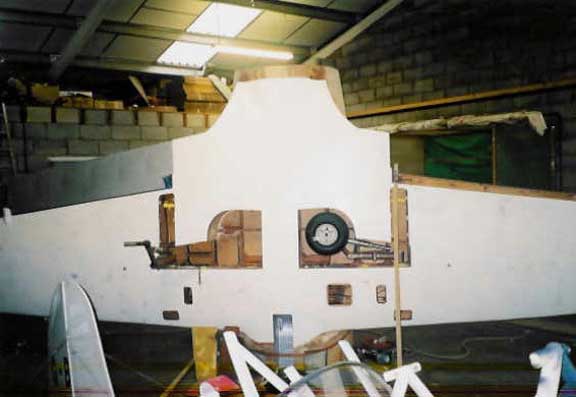
The wing primed and painted.
David Almey kept on slowly working away on the project, overhauling the undercarriage, re-chroming and machining the axles and struts. He eventually assembled the airframe, checking overall setting out and dimensions. All measured within 1mm, so obviously the Falco airframe is not only structurally strong but will also stand long periods of poor storage. A few areas of moisture-damaged skin covering on the bottom of the rear fuselage were replaced.
After about two years of construction, I decided that the four-seat Jodel project was going to be uneconomic, and would cost more to build than it would be worth. Dave Almey then offered me the Falco project. After much thought and discussion with friends, I eventually managed to convince myself I could finish the project and be able to sell it if I wished without losing vast sums of money. This of course was a very sensible decision. Maybe my exposure to the project had made me sentimental about the aeroplane. Or maybe the comments from my friends: “A Falco, of course, buy it and finish it—we will fly it with you!” had persuaded me to buy, but hold on—I still needed approval from ‘Mission Control’.
My previous experience of aircraft building consists of refurbishing our Jodel D119 two seat plane and, of course, work on the now abandoned four-seat Jodel DR200 project. My wife, Sian had helped with refurbishing the D119 and after much discussion, the response came: yes, I could take on the Falco; no, she was not going to help with the major construction of this project. Some conditions to approval have been set, however. When the aircraft is finished European touring, in particular a visit to Prague is in the offing. In the meantime while I am building, Sian is out flying the D119 (possibly a cunning plan when she gave me the go-ahead).
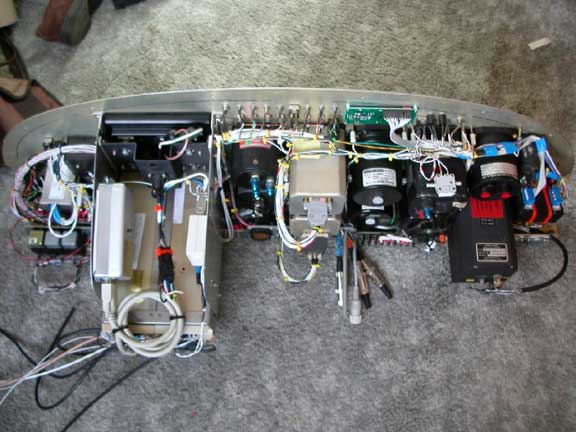
The instrument panel
Well, Sian and I are now proud owners of Falco PFA project number 100-10588. I only have the airframe, electrical installation, instrument panel, tanks and plumbing, brakes, undercarriage, engine and miriad other details and parts to install and fit. I will keep you informed of progress as and when progress is made. However, I am definitely going for the medal for completing the oldest and longest construction period for a Sequoia Falco.
Along with enough wood to look like an aeroplane came an equal mass of paper. Several sets of plans, build book, 20 years of Falco newsletters. First off is to register my involvement with the PFA, establish that the PFA records are in order, and acquire a licence to build from Sequoia. That done I can really call myself a Falco builder. But what to tackle first? Read the newsletters first. One a night just before bed, just what the doctor ordered. Lots of information, instantly forgotten, on the finer points of Falco construction. How to balance the flying surfaces, strengthening the fuel tanks, etc. Even a few encouraging flight reports. It seems some people do actually finish and fly their project. Looking through boxes of bits that David kept throwing at me arrived an instrument panel. Winter weather, cold outside, start with this on the kitchen table.
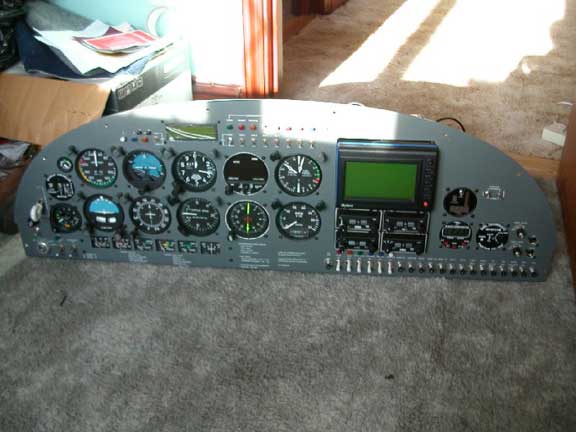
Pilot's end of the instrument panel
Fortunately for me much of the wiring for the panel was already completed. However it did not stop the drawings being brought out, and a continuity check carried out on all cables so far installed. Continued with the engine cluster, audio panel, and some changes of my own making. Installed Terra Comm, VOR, ADF and Transponder, along with Skyforce GPS. Why Terra? I already had the Comm and transponder for my previous project. However I have now realised my deliberate mistake. I have to have the aeroplane finished and flying before 2008, otherwise this will be the first Falco to have an avionics re-fit before completion and flight. This is because of the requirement to fit mode-S transponders in Europe by that date. I now have to complete the aeroplane because the panel wiring and fitment has taken me six months, and I can’t face re-doing this before flight.
Was anything difficult? No, it just took a long time, and I hope it all works when it is all finally hooked up, otherwise I have a feeling I could take the rest of my life to troubleshoot the system.
|
|